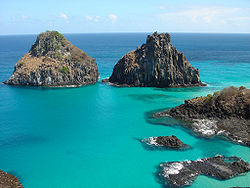Archipelago

An archipelago (![]() /ɑrk
/ɑrkɪˈpɛləɡoʊ/, ark-i-pe-lə-goh) is a chain or cluster of islands that is formed tectonically. The word archipelago is directly derived from the Greek ἄρχι- - arkhi- ("chief") and πέλαγος - pelagos ("sea"). In Italian, possibly following a tradition of antiquity, the Archipelago (from medieval Greek *ἀρχιπέλαγος) was the proper name for the Aegean Sea and, later, usage shifted to refer to the Aegean Islands (since the sea is remarkable for its large number of islands). It is now used to generally refer to any island group or, sometimes, to a sea containing a large number of scattered islands like the Aegean Sea.[1]
Contents |
Types of archipelago


Archipelagos can be found isolated in bodies of water; or a large land mass may neighbour them. For example, Scotland has more than 700 islands surrounding its mainland. Archipelagos are often volcanic, forming along island arcs generated by subduction zones or hotspots, but there are many other processes involved in their construction, including erosion, deposition and land elevation.
The five largest modern countries that are mainly archipelagos are Japan, the Philippines, New Zealand, the United Kingdom and Indonesia. The largest archipelagic state in the world, by size, is Indonesia.[2] The archipelago with the most islands is the Archipelago Sea in Finland.
See also
- Island arc
- Geography
- Earth science
- Geomorphology
- List of landforms
- Plate tectonics
- island country
- Earthsea
- The World
- List of Archipelagos by number of islands
- Lists of islands: see List of archipelagos and List of islands
References
- ↑ "Archipelago". Farlex, Inc.. 2008. Archived from the original on 2008. http://www.thefreedictionary.com/archipelago. Retrieved 2008-10-02.
- ↑ "Indonesia". The World Factbook. Central Intelligence Agency. 2008-12-04. https://www.cia.gov/library/publications/the-world-factbook/geos/id.html. Retrieved 2008-12-07.
External links
![]() Chisholm, Hugh, ed (1911). "Archipelago". Encyclopædia Britannica (Eleventh ed.). Cambridge University Press.
Chisholm, Hugh, ed (1911). "Archipelago". Encyclopædia Britannica (Eleventh ed.). Cambridge University Press.
| This article about geography terminology is a stub. You can help Wikipedia by expanding it. |